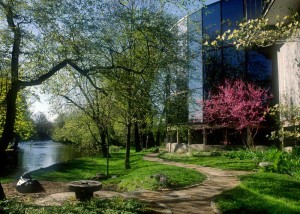March program offers wide range of local subjects from art to nature
By Gene Pisasale, Special to UnionvilleTimes.com
PENNSBURY — The many rapidly flowing streams in southeastern Pennsylvania were logical places for settlers in the 1700’s and 1800’s to build grist mills, using the power of running water to turn wheels and grind corn and wheat into flour. In 1864, as the Civil War raged in neighboring states, George Brinton built Hoffman’s Mill at a well-traveled crossroads near present day Chadds Ford. In 1967, Hoffman’s Mill and the surrounding land was purchased by the Tri-County Conservancy under the auspices of local artist George “Frolic” Weymouth to preserve the meadowland on the banks of the Brandywine. In addition to land conservation, the other main project was restoring the mill. Work began in March 1970 and by its opening on June 19, 1971, the building had been converted into the Brandywine River Museum, its newly renovated rustic façade standing proudly along the riverbank. Today the millstone is a symbol of the Brandywine Conservancy and several of them dot the museum property.
Ever since Howard Pyle brought his art school to Wilmington around the year 1900, the local rolling hills, tree-lined riverbanks and adjacent structures have been the subject of hundreds of paintings in what became known as the Brandywine School. Perhaps the most interesting aspect of this movement is the subtle interplay of art and nature, showcased in such elegant pieces as “August” by Weymouth, “Pennsylvania Landscape” by Andrew Wyeth and “The Spring House” by N.C. Wyeth. Aside from the many paintings by the Wyeths over the last century, names such as Barclay Rubincam, William Trost Richards and Rea Redifer come to mind as ones who cherished the history and natural beauty of this area, making them a focus of their work. It is the special bond between the artist and the inspirational natural surroundings that produces truly great works of art which stand the test of time. Whether realist, abstract or post-modern, artistic creations in this sublime setting have reflected the delicate grace of flowers, trees and flowing currents nearby through piercing hues and deft brushstrokes.
Due to rapidly expanding housing developments and industry, land conservation has become a major cause for preservationists throughout the United States. It is because the southern Chester County region has become such an attractive a place to live and do business that citizens across the political spectrum have come together to shield treasured areas from the encroachment of progress. Their efforts often intertwine with those of the museum, with artists painting protected landscapes and conservationists preserving the environment which forms their subject matter. Regional planners and horticulturists regularly coordinate their work with that of the Conservancy, with programs discussing this symbiotic relationship a focus for both groups.
The Brandywine Conservancy has been dedicated to not only preserving our precious landscapes, but also spreading the word about conservation through a series of workshops and lectures. This Spring the museum begins its 41st year with improving public awareness of its history and ongoing projects. In March, there will be a series of late morning lectures each starting at 11 a.m. highlighting these topics. On March 14, associate educator Jane Flitner will present “Art and Nature”, featuring works of art from the museum’s collection. The following week, senior planner Sheila Fleming will present her lecture “The Brandywine Creek Greenway” focusing on environmental management along a 30-mile corridor running from Honeybrook to Chadds Ford. Horticulture coordinator and photographer Mark Gormel will give a first hand look at the plants and animals of the region in his talk titled “Native Plants of the Brandywine Region and their Liaisons” on March 28th.
When visiting the Brandywine River Museum, you’ll see not only a large collection of outstanding paintings by their native sons the Wyeths, but also many other people who spent time in the region and captured its rural beauty. One comes away from a tour through the Museum with a greater appreciation for the important place these artists hold in the great family of American landscape painters. So, the next time you see a work of art by one of this area’s well-known talents or simply view one of the magnificent protected panoramas around the Brandywine Valley, remember that it’s all possible because a visionary artist captured a moment in time… and a conservationist helped preserve it, for us all to enjoy.
For information on the Museum, go to www.brandywinemuseum.org. For more information about the author of this article, visit his website at www.GenePisasale.com or e-mail him at Gene@GenePisasale.com.







